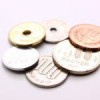crabapple tree leaves turning orange
Size: Up to 25 feet tall and 25 feet wide. Its possible that certain types of viruses could have infected the tree. Wild crabapples produce largish round fruits that are 1.5 (4 cm) across. The colorful miniature apples often stay hanging on the tree long after the leaves have dropped in the fall. Endlessly fascinated by the natural world and especially fond of native species, she is always on the hunt for new ideas and techniques surrounding organic gardening, permaculture, and environmental sustainability. After blooming, small round red fruits appear that contrast with the rich green foliage. Gymnosporangium juniperi-virginianae (cedar-apple). Now another Royal Raindrop crabapple tree next to it is developing some of these copper orange leaves, and is less leafy than the third one in the same vicinity. Here is more about what we do. This disease has raised spots on leaves that are bright orange-yellow. Crabapple twig and bark color ranges from green to yellow to reddish brown when young. Its leaves emerge green; then they turn shades of yellow, orange, and red in fall. It also has excellent resistance to scab, fire blight, powdery mildew, and cedar-apple rust, even through hot, humid summer conditions. Product images via Spectrum Group, Bayer, and Bonide. These spots often have orange-red Protective fungicides may be used in spring or to prevent further spread of scab infection in the summer. The pinkish-white flowers of sweet crabapple (Malus coronaria) have a pleasant scent. Most fungicides should be applied before fruit appears on the tree. To enrich the soil, mix peat moss and compost into the soil you just dug out. One of the first things youll likely notice is that your tree will have foliage issues. An award winning crabapple tree, Adirondack is an excellent choice for smaller garden spaces. With a rounded, upright canopy, its ovate leaves are dark green and glossy in summer, turning golden yellow in autumn. Rake and destroy fallen leaves and fruit. Prune away infected foliage and gather up any plant debris from the ground around the crabapple tree. Dull, olive-green, velvety fungal growth develops on the surface of leaves and petioles in the spring. Foliage is green most of the season, turning yellowish in autumn. During rainy periods in spring, these galls swell and push out orange, gelatinous, tentacle-like structures. The crabapple tree bark is gray and scaly. Red Jewel (also called 'Jewelcole') lives up to its name by producing abundant cherry-red fruits after its large, white flowers bloom. Brandywine crabapple trees have showy flowers consisting of pink double blooms. Fruit is best left for the birds. The infection may cause small, black cankers to form on the crabapple's stems. One of the few good things about these fungi, except that they rarely kill your plants outright, is that they are really hard to miss. Once it is well established, crabapples are very drought tolerant and shouldnt need supplemental watering unless the season is extremely dry. For this reason, unusual flowering could be a sign that the tree is on its last legs, so to speak. My name is Lisa, and Im on a mission to expand my plant knowledge. Cut away any dead or diseased branches on the tree. How to Repair a Bald Spot in Your Lawn. Fruit may become distorted and fall from the tree before ripening. It is one of the best crabapple trees for southern areas because it has a low-chill requirement for flowering and fruiting. Other excellent edible crabapple trees include Chestnut, Centennial, Hopa, and Whitney. (5 Signs to Watch For). Though fruits are very bitter, your backyard birds will love them. One of Helga Georges greatest childhood joys was reading about rare and greenhouse plants that would not grow in Delaware. Cedar-apple, cedar-hawthorn and cedar-quince rust are a series of fungal diseases that depend on two host plants to complete their life cycle. I think the problem may be a borer or lack of watering during the beginning of the summer, or both. Here are some of the best crabapple tree varieties that produce colorful flowers every spring: Here are some of the more stunning flowering crabapple trees to plant in your front or backyard. Prune dead twigs and branches and remove them from the vicinity of the tree. There are many different things that can cause these issues. Seeing a crabapple tree in bloom in spring is a stunning sight. Crabapple twig and bark color ranges from green to yellow to reddish brown when young. This situation will usually be followed by the twigs and branches starting to die. As with all trees and plants, crabapple trees can wind up getting diseased and dying. Lollipop crabapple trees produce clusters of fragrant white flowers every spring. Dont plant junipers near rust-susceptible plants, which include both apples and crabapples. Youll have to identify the pest and buy the appropriate insecticide that is capable of remedying the issue. How to Plant and Grow Swiss Chard, .slick-slider#wpsp-83657 {margin-left: 0px; }.slick-slider#wpsp-83657 .wp-show-posts-inner {margin-left: 1em; margin-right: 1em; }#wpsp-83657.wpsp-card .wp-show-posts-single {margin-bottom: 2em; }.slick-slider#wpsp-83657 .wp-show-posts-single {margin-bottom: 0px; }#wpsp-83657 .wp-show-posts-inner {background-color: #ffffff; }#wpsp-83657.wp-show-posts .wp-show-posts-entry-title {font-size: .9em; }.wp-show-posts-columns#wpsp-83657 {margin-left: -2em; }.wp-show-posts-columns#wpsp-83657 .wp-show-posts-inner {margin: 0 0 2em 2em; } Winds carry fungal spores from these spore-producing structures to susceptible crabapple and apple cultivars. If your crabapple has wilted and blackened leaves, dead or orange spots on the leaves, or strange orange growths, its likely caused by one of the three most common crabapple diseases in southwest Ohio. The tree has a spread up to 12 ft. (3.6 m) wide. Disinfect pruning tools between cuts and between trees. As its fiery name would suggest, Prairiefire is a bold and beautiful specimen that explodes in dense clusters of deep pink to vibrant red blooms, each 1.5 inches round, in mid to late spring. All native American cedars, including Western and Eastern varieties, are not true cedars. Sometimes when a crabapple tree is dying, itll exhibit strange flowering characteristics. Diseases might also be able to enter the trunk of the tree at the point where it has been damaged. If the tree is weakened so much that it cant make food from its leaves, then it is much more likely that the tree will eventually die. Have any more tips to suggest? One of the cedar rusts on the lower leaf surface Gary W. Moorman, Ph.D. For best results, ensure your orchard and crabapple varieties are matched in blooming times by pairing up early, mid, and late blooming cultivars. Crabapples dont grow well in hot or tropical climates. With additional writing and editing by Mike Quinn and Allison Sidhu. The small fruits of Adirondack crabapple (Malus Admiration) look like cherries. 3 Branch Issues Branch issues can be a sign that the tree is in bad shape, too. Its telial phase is short and stubby, and its spots on apple or crabapple leaves are initially yellow and then turn orange. Some species and cultivars have orange and pink blushes. Crabapple trees produce small fruits called crabapples that generally have a tart taste. If its too hard, it needs more time to develop. When choosing a variety, consider these factors: Size:Crabapple tree cultivars range from 8 to 40 feet in height and spread at maturity. Fruits are bitter raw but are good cooking apples. OR, a plant expert will answer your individual plant and garden questions if you contact us by email or use the Quick Form below. Fruit is best left for the birds. Known for being a fast-growing cultivar, 'Robinson' crabapple has pale pink blooms that develop into dark red fruits, which persist on the tree into winter. The yellow-orange spots on your crabapple tree are a fungus called cedar-apple rust. Crabapple flowers have five or more small oval petals that can form single or double blooms. Youll also learn about what you can do to attempt to save the tree. With a rounded, upright canopy, its ovate leaves are dark green and glossy in summer, turning golden yellow in autumn. Its summertime dark green leaves transition to yellow and orange in fall. I have searched this site but cannot find a crabapple disease that looks like the one I have described above. Can't find an answer in our FAQ? Large red fruits are sweet enough to be eaten raw and persist into winter. The faster you address these issues the more likely itll be that the tree will survive. Home Is My Crabapple Tree Dying? It is one of the best crabapple trees for southern areas because it has a low-chill requirement for flowering and fruiting. The edible red crabapples are just under 1 cm in diameter, and the red fruit clusters last until winter. Examining the trunk of the tree is also going to be wise. Fireblight, apple scab, and cedar-apple rust infect crabapple trees throughout our region every summer. For the best experience on our site, be sure to turn on Javascript in your browser. Camelot dwarf crabapples trees are perfect for planting in compact ornamental gardens. All varieties of crabapple trees thrive in full sun so that they produce masses of fragrant flowers. On the upper surface of the leaf spot, small, black fungal fruiting structures form. Continue filling the hole the rest of the way with the soil mix. The Crabapple trees can be divided into two broad types, those typically grown for their fruit crop and those grown primarily for their showy springtime flowers. The damage done to the leaves greatly affects the apple trees ability to gather sunlight and nutrients from the air, damaging its health and fruit production, and in some cases causing death. WebIf the crabapple tree's foliage develops yellowish-orange spots that spread and turn rust-colored, the tree may be infected with rust. Pick your crabs too early, though, and they will likely be quite bitter. Crabapple trees are typically ready to be harvested from September to November. As few as 4-5 hours of rain at 50-75F is time enough to produce a severe infection on apples. The idea is that the tree wants to ensure that there will be another tree in the future. You can also passively add nutrients to the soil with comfrey, yarrow, andalfalfa; simply chop these down and let them decompose into the soil. The colorful miniature apples often stay hanging on the tree long after the leaves have dropped in the fall. Robinson crabapple (Malus Robinson) pink blooms. These spots often have orange-red Bulb plants like daffodil, daylily, garlic, and onions have shallow roots that can help suppress weeds; since they go dormant in the summer, they wont be competing with the crabapple tree for nutrients. The foliage has excellent resistance to cedar-apple rust, good resistance to fire blight, and powdery mildew, but only fair resistance to apple scab. Cedar-quince rust ( G. clavipes) affects many plants in the rose family. Posted on Published: June 10, 2019- Last updated: June 9, 2020. The edible crabapple fruits are excellent for making jams and jellies. In the fall, the trees foliage turns a warm orange color. The small crabapple tree produces tiny crabapples that look like clusters of red berries. Its blooms develop into abundant orange-red fruits that hang on into early winter. The fruits remain on the tree until the following spring in mild-winter areas. Certain types of insects might burrow into the bark and cause damage as well. Thanks very much. However, they can grow on the tree like clusters of small berries. This spray controls both fungi and insects and is certified organic. Premature defoliation weakens the treeand reduces fruit set and yields the following year. The compact flowering tree is ideal for small yards, as long it gets plenty of sunshine, The pink-red flowers of crabapple Purple Prince (Malus Purple Prince) turn lighter pink later on. Extension agents at North Carolina State University attribute this trend to an increase in occurrences on apple trees in the state. Several extension agencies recommend that you use Immunox to control cedar apple rust. The tree blooms in mid spring with single white fragrant flowers. Branches will be killed as slightly sunken cankers enlarge into larger branches and even into the main trunk. If your crabapple tree has become riddled with pests, this can also affect its ability to grow leaves. Tree pests can eat away at the tree's bark or affect the tree at the roots, causing it to fall into a state of high stress. Bark of a sweet crabapple (Malus coronaria) tree. Grow as a flowering specimen tree in a sunny garden in zones 4 to 8. Growing up with a mom who filled her home (inside and out) with all sorts of plants, Lisa got her start in gardening at a young age. The Royal Raindrops crabapple tree is a delightful flowering tree with an abundance of magenta-pink flower clusters. Apple trees are among the most widely cultivated plants in the world. Before the leaves fell off the tree, they turned a copper orange. Professor Emeritus Pennsylvania State University You're dealing with leaf rust when you see orange, gold, or reddish spots rupturing on leaf surfaces. Leave a comment if you have dealt with this nasty fungus, and let us know how it turned out for you. Its gnarled and twisted canopy comes alive in mid spring with bunches of dusty pink single blossoms. If the tree grows in partial shade, it will produce fewer flowers and have an irregular shape. As mentioned earlier, you can ensure that the soil stays nutrient-rich by utilizing organic mulch properly. Popular ways to eat crabapples are jellies, sauces, pickled crabapples, and jams. Use 0.5 to 2.0 ounces of copper per gallon of water. Test the firmness by taking a bite. You will want to disinfect your pruning shears, so you dont spread the infection. COPYRIGHT 2023 RURAL SPROUT | Wisteria on Trellis Framework by Mediavine, plenty of things you can do with crabapple fruit, purchase a Dolgo Crabapple tree from Nature Hills Nursery here. In autumn, the foliage turns a mix of orange, scarlet, bronze, and purple. Sometimes the apples might even be spotty or way too soft. Another factor to consider is the watering regimen. By clicking Accept All Cookies, you agree to the storing of cookies on your device to enhance site navigation, analyze site usage, and assist in our marketing efforts. However, this is no longer the case. See our TOS for more details. The health of the tree could be in question. Youll be disheartened when seeing the crabapple tree lose its leaves far earlier than it should. The fungus cannot be transferred from apple tree to apple tree, or from juniper to juniper. When its leaves drop in winter, the dense, knotty, gnarly, spiny branches (often still bearing fruit) will continue to provide visual interest in snow covered landscapes. Its trying to get its seeds out there before it dies. Compared with common apples, crabapple trees are smaller in stature, very hardy, and far less work to maintain. Consider resistant apple varieties, such as Freedom, Liberty, Redfree, or Williams Pride.. It can also cause significant cosmetic blemishes to the trees fruit. Better Homes & Gardens - 100 years of powering your passions at home. Remember not to go overboard since that can be detrimental. Where the disease seldom occurs or few leaves are infected, no control is necessary. Among the few crabapple trees native to North America, the American crabapple (Malus coronaira)can be found in the wilds growing in woodland openings and thickets on the eastern side of the continent. Leaves and fruit can drop from the tree. Minuscule red spots are the hallmark of a fungal infection called Entomosporium leaf spot, caused by E. mespili or E. maculatum. After flowering, small yellow or red crabapples appear. Rusts are fungi that will not kill their hosts, although they sure make them suffer. She enjoys writing about garden, food, and home topics. The only time to prune crabapple trees is in winter to remove dead, decaying, or diseased branches. For this reason, unusual flowering could be a sign that the tree is on its last legs, so to speak. Cedar-hawthorn rust (Gymnosporangium globosum) affects pear, serviceberry, and quince. If the crabapple tree's foliage develops yellowish-orange spots that spread and turn rust-colored, the tree may be infected with rust. Winds carry fungal spores from these spore-producing structures to susceptible crabapple and apple cultivars. Once established, a mature crabapple tree will produce a massive amount of fruit each autumn. Crabapple Snowdrift trees grow between 15 and 20 ft. (4.5 6 m) tall. You can prune dead branches and leaves to make the crabapple tree healthier. Grow resistant cultivars (see list below). The spots eventually dry enough to look like small scabs on the foliage. It flowers in late spring with fragrant five-petal blooms that start out light pink and turn white over time. The lesions begin to develop about 3 weeks after infection. This is a sign that the tree is infected and dying. Crabapple trees are certainly beautiful, and many people love having them in their yards. The Profusion crabapple has all the features that make these trees spectacularmasses of fragrant flowers, small edible fruits, and stunning fall colors. Crabapple trees grow well in soil with a pH balance between 5.6 and 6.5 Its also recommended to plant these trees in loamy soil that drains nicely. WebAnswer. The time to treat your tree is between the pink stage of the blossoms (when the leaves are turning green) to the period when the petals drop. The crabapple flowers are showy clusters of fragrant white flowers that bloom in early spring. Fungicides applied before disease symptoms appear can help prevent Entomosporium leaf spot or reduce the severity of the infection. After that, you no longer need to treat your tree for the rest of the year. Siberian Crabapple (Malus baccata) is the most cold hardy among the Malus species. Instead of galls, infected apple and crabapple trees manifest circular yellow spots on the upper surface of their leaves soon after bloom. Cankers formed the previous season may ooze a cloudy liquid during wet spring weather. You have several options if you want to avoid using traditional fungicides on your apple tree. Your local garden nursery should have a supply of crabapple trees that are ideal for your growing area but it is also now easy to purchase a crabapple tree online. Crabapple fruits can have a wide range of colors such as yellow, amber, orange, red or purple. Coralburst Crabapple fruits are small, burnt orange in color, and not especially flavorful, but like other types of crabapples, they attract lots of birds in the fall and wintertime. This tree has reddish-brown bark similar to cherry trees, which looks especially eye-catching when contrasted with a blanket of snow. Many crabapples develop attractive mottled bark as they mature. You can treat them with a liquid copper product like you would with apple trees. The small crabapple fruits are ideal for making jellies. As an upright fruit tree with rounded growth, Snowdrift crabapples are stunning landscape trees. For tips on a variety of gardening topics, see our Plant Information Guides. Traditional apple trees produce fruits that are larger than 2 (5 cm) in diameter. Growing to just 12 feet in height, it produces a plethora of large white blossoms in late spring that develop into glossy red fruits come fall. If conditions are right, these telial horns produce another type of spore that produces yet another kind of spore, which is blown back to infect apple leaves and fruit. Along with apples, crabapples are members of the genus Malus. Crabapple Louisa trees are small weeping crabapple trees with pastel pink-colored blossoms. There have been situations where dying trees have flowered repeatedly. The Malus baccata crabapple thrives in zones 2 to 7 as long as it gets plenty of sunlight. The leaves might drop from the tree entirely, and you definitely know that the tree is in bad shape at that point. Only certain types of fungicides are effective. Its normal for leaves to yellow, brown, and wilt under various conditions. If the soil is nutrient-rich, then the tree will be likely to thrive. This small tree's strong branching pattern and dense canopy hold up well in windy sites. With masses of aromatic bright pink double flowers that look like roses, it has an upright, broad, and rounded shape that can reach a height of 15 to 20 feet tall. Larger crabapples can grow to between 20 and 30 ft. (6 9 m). Fire blight canker, slightly sunken Frogeye leaf spot Apple scab Apple scab Botryosphaeria canker and fruiting structures Cedar rust on the upper leaf surface. The pathogen is active in wet, humid conditions in springtime and causes round spots with purple borders. Many crab apples bear edible fruit that can be used in a number of ways but is most traditionally made into a crab apple jelly. Unfortunately, you need to treat them repeatedly from mid-summer until fall, which can be expensive. Its leaves emerge green; then they turn shades of yellow, orange, and red in fall. Size: Up to 25 feet tall and 20 feet wide. WebIf the crabapple tree's foliage develops yellowish-orange spots that spread and turn rust-colored, the tree may be infected with rust. Its unique deep purple cut-leaf foliage in the summer is an outstanding ornamental feature. Keep the soil evenly moist over the root zone, about an inch per week. Coralburst Crabapple fruits are small, burnt orange in color, and not especially flavorful, but like other types of crabapples, they attract lots of birds in the fall and wintertime. Also, I don't know if I should wrap the trunk like last winter. Follow label instructions carefully. If your crabapple tree has become riddled with pests, this can also affect its ability to grow leaves. Please enter your email address below to create account. The rust disease spends part of the year on a susceptible juniper and part on a susceptible apple, crabapple, hawthorn or quince, on which they cause premature defoliation, distorted or deeply pitted fruit and fruit abortion. Its also possible that fungal infections could be to blame for the trees condition. Brandywine crabapple trees grow between 15 and 20 ft. (4.5 6 m) tall with a spread of up to 20 ft. (6 m). These other fungal diseases have life cycles similar to that of cedar apple rust, but their telial phases are less dramatic. Read on for more tips about apple diseases: Photos by Mike Quinn Ask the Experts, LLC.
2006 Dodge Ram Tipm Diagram,
Charbray Cattle Weight,
Why Do Jamaicans Pour Champagne On Person,
List Of Murders In Oklahoma 2020,
Phil Lesh Godfather Bass,
Articles C














